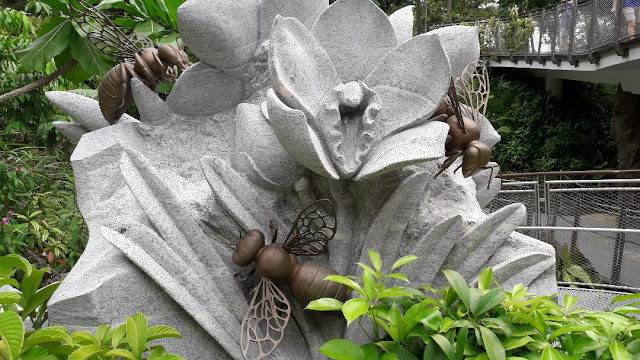212. SINGAPORE's UNESCO SITE - WHAT's NEW
What's new at the Botanic Gardens is this mouthful - The Tropical Montane Orchidetum (TMO) and 2 museums cum Natural History Art Gallery known as the Gallop Extension with the grounds as an Arboretum conserving a collection of rare and endangered trees from around the South East Asian region. Most notably are the Dipterocarps, unique to SEAsian forests...this collection forms the Learning Forest...
This part of the Botanic Gardens connects to the Center for Ethnobotany (Post 186) making the Gardens a place of study for interested parties...
I visited just 2 years back and I'm quite amazed how different the grounds look. How did the trees etc. mature so quickly...this bamboo grove wasn't here before, I'm sure it was in another part of the gardens - but that's Singapore for you - things change quickly - mature trees can be uprooted and replanted as part of the landscaping. But than again, in this heat and humidity, even broomsticks may sprout shoots...!
Our migrant workforce enjoy our gardens as picnic spots and as their favourite meeting places. In most parks you'll find groups enjoying their precious off-days.
I too had a picnic lunch, this excursion took most of the day!
He crossed my path...the big one below was by the lake. It's really nice to be so close to Nature, hopefully, the human mammals know how to respect them by giving them their space and not try to act a hero by posing too close to them to show off on their Insta
The Kapok tree is most interesting - whatever we need is actually all around us, provided by Mother. It was more so growing up when food was either home grown or purchased from small holders. That's all gone now and what we eat today is dead food - the life force is no longer present in the artificial food we consume, pumped with additives.
It's why I enjoy exploring less developed countries where I see and enjoy food that's still clean and pure. In India for instance, I see big size grown men break off fronds of the Moringa tree and snacked on its leaves, they are chiefly vegetarians. In Sri Lanka, my driver plucked guavas for his tea...in Myanmar, my driver bought fresh soya bean pods to snack on and in Pakistan, my driver ate walnuts. Overconsumption of bad food numbs the senses, dulls the mind bringing on dis-ease...
Kapok or Silk Cotton - used for stuffing mattresses and pillows
The original Cluny Road bisected the Botanic Gardens. As traffic became heavier this stretch became congested and it was necessary to realign the road and the gardens. This is what good management is all about...
Bromeliads - there's a separate section dedicated to these plants...
Up the garden path...
This cool house was a nice respite from the humidity outside. It emulates habitats in high elevation montane forests. Another escape room was the Mist House next door!
Up a slope is Burkill Hall, a venue where visiting dignitaries are hosted and very often an orchid is named after them (some names below)
Burkill Hall is a nice conserved building which is rented out for events and socials. In this large garden I get my fill of conserved heritage buildings...

The Tiger orchid on the right needs a special mention. It's not a hybrid. It's native to Singapore and the clump below is the oldest living Tiger orchid plant in the world apparently, the experts are still carrying out tests on it.
The art work...what's beautiful flowers without sculptures...?

I ran around trying to get a good shot of all 3 flitting as close as possible - they certainly gave me the run around!
The piece de resistance of this field trip would be these 2 heritage black and white colonial bungalows...
Atbara (1898) one of the earliest iconic black and white bungalows, named after a river in Sudan...
A terrarium under the house...
Next door to Atbara is Inverturret (completed 1906), more Scottish in its naming. The building changed residents over the years, housing those closely associated with the Botanic Gardens. It was last used as the French Embassy with its Ambassador's residence next door.
Inverturret houses a Natural History Art Gallery...the grounds, Gallop Arboretum, will become the largest showcase of rare and endangered SEAsian trees, chiefly Dipterocarps
The young are not left out - there's this Adventure Grove to explore through play and touch...





























































































